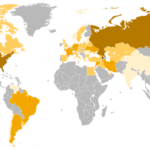Companies are to invest $40 billion to recover the rest of the ACG reserves, in Azerbaijan
Azerbaijan is hoping to produce more oil by the end of 2049 than it has produced to date on the Azeri, Chirag and Deep Guneshli (ACG) fields, in the Caspian, thanks to the implementation of enhanced recovery techniques. But in order to achieve this, $40 billion will have to be invested, a very large sum given current crude oil prices, which could put a strain on the profitability of the operation. An agreement was signed to this end on September 14, 2017, between Baku and the consortium of companies led by BP, which currently exploits ACG. The role of operator is still assigned to BP. The share of the Azeri state-owned company Socar, which currently stands at 11.65%, is going to rise to 25%. The shares of the other companies will be lowered on a pro-rata basis (see table). Foreign firms are going to pay the Azeri State a bonus of $3.6 billion in eight annuities. It is uncertain whether or not this bonus will be considered as a cost, and hence recovered. Also unknown at this stage are the terms by which the production from ACG will be shared between the partners, after the costs are recovered. According to Socar’s President, Rovnag Abdullayev, “the terms of the new contract reflect the growing financial and technological potential of Azerbaijan and Socar”.

Azerbaijan: BP ensures that the future exploitation of ACG will be profitable at a price of $55/b
The new contract that has just been signed is described as an “amended and restated agreement on the joint development and production sharing” of the ACG fields. The original contract (to which it is referred here) goes back to September 20, 1994. The partners are going to undertake “further engineering development work to evaluate the introduction of an extra production platform in the ACG area”. BP CE Bob Dudley said the aim of the move is to “work together to unlock the long-term development potential of ACG through new investments, new technologies and new joint efforts to maximize recovery” of the remaining reserves of these three fields. What volume of reserves do the latter hold? Azerbaijan’s President, Ilham Aliyev, announced the figure of 500 million tons, i.e. around 3.8 billion barrels. BP has not disclosed a precise figure. Yet the UK major has said that, to date, it has extracted 3.2 billion barrels of oil from ACG, as well as 30 bcm of associated gas (the latter was supplied to the Azeri State free of charge, in line with the 1994 contract). In the past, BP had pointed out that it put ACG’s initial recoverable reserves at 6-7 billion barrels. There are therefore an estimated total of 2.8 to 3.8 billion barrels left to produce. The Turkish company TPAO puts the figure for the remaining reserves at more than 4 billion barrels.
The negotiation that led to this production-sharing agreement (PSA) seems to have started in 2012, when Ilham Aliyev called on companies to halt the decline in ACG production. The latter had peaked at 835,000 b/d in 2010, before starting to tail off, while the official target (“the promise” made by companies, said Aliyev) was 1 million b/d. Thus, the BTC oil pipeline to the Mediterranean has been designed with a capacity of 1.2 million b/d. The ACG’s current output is 585,000 b/d. BP is trying to stabilize it by boosting the volume of injected water and gas. In order to take the current efforts further and maximize the recovery of the reserves, very large investments must be agreed to over several years. Companies did not want to commit themselves to these investments without having the prior assurance that they will have the time and possibility of recovering their money. Hence the need to conclude this new agreement.

The 1994 PSA was negotiated and concluded in a price context of $16-17/b. This corresponds to a present value of around $35 to $40/b. When the new contract was announced in Baku, Bob Dudley announced that the future exploitation of ACG will be profitable at the current price of $55/b. Since 1994, $32 billion have been invested by companies, says Socar. The Azeri state-owned firm has also pointed out that, since 1997 (the year of the ACG’s production start-up), its government has received $125 billion in “direct net profits”, i.e. an average of $6.25 billion/annum.
According to PETROSTRATEGIES’ estimates, the Azeri State’s oil revenues peaked at some $17-18 billion/annum at the height of ACG’s production, and when crude prices were hovering around $100/b. They probably fell to around $4 billion in 2016. How much can Baku hope to make within the framework of the new contract? On the basis of a hypothesis of a future output of 3.5 billion barrels, together with a price of $55/b in constant terms, operating costs of only $5/b and pipeline transport costs also at $5/b, the net profits that could be generated from the future exploitation of the ACG come to around $100 billion. The State’s share (25% of Socar + share of the profit oil + profit tax) could stand at around $75 billion over 32 years. Or more, if oil prices climb, of course.
In the 1994 contract, the share of the profit oil earmarked for the State depended on three main factors: companies’ rate of return (or RROR), the cost of the pipeline transportation and the date of the initial production start-up (early oil). The most favorable profit oil ratios for the State (represented by Socar) ranged from 30% to 80% (see table). The State also applies a 25% tax on companies’ profits. A signature bonus of $300 million had been paid in 1994: it was not recovered by the companies.













